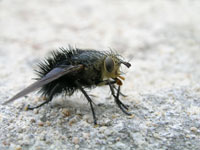Flies |
 The noun fly is a general term for any insect in the order Diptera. This includes several thousand species with considerable variation in appearance and behavior, all united by the fact that they have only a single pair of fully-developed wings, the lower wings being vestigial and used as an aid in balance rather than for flight. Some of the more common species in this group are houseflies, mosquitoes and midges, but it is estimated that over half of the members of the order have yet to be described. In the common vernacular, the word fly has been erroneously used for many small flying creatures which are not true flies, such as dragonflies, caddisflies, whiteflies and others. Diptera is subdivided into two suborders, Nematocera and Brachicera, the latter being further divided into the infraorders Tabanomorpha, Asilomorpha and Moscomorpha. When the average person thinks of a fly, they will usually picture a member of Muscomorpha with a short, stocky body and bristled, three-segmented antennae. These are the flies that buzz around our living rooms in the summertime. They originally evolved to eat animal feces and rotting flesh, but in recent centuries they have developed a taste for human garbage. Flies now exist practically anywhere there are people, in a wide range of climates and conditions. As they follow us, flies cause problems. They like to eat the same things we do, and the damage they cause to our food stores is literally incalculable. In the absence of refrigeration, food is often spoiled by the presence of maggots which hatch and immediately start eating. Flies also provide a vector for many diseases such as malaria, dengue fever, West Nile virus and others. The risk is particularly great in the case of biting flies like mosquitoes, since they actually exchange blood with their hosts. However, even the flies that don't bite can transmit disease by picking up germs and transmitting them to our food on their contaminated limbs and in their feces. Because they are associated with unpleasant things like rotting flesh, and since disease has a habit of following wherever they go, flies have acquired a cultural connotation of uncleanness and unhealthiness. In the Bible they symbolize death and decay, an idea that survives today. They are the subject of morbid poetry and bad science fiction films, and they seem to always be buzzing around in our minds, if not in our faces. However, flies do have their uses. They have helped the police on many occasions. Since maggots mature at a very predictable rate, their presence on a corpse can be used as a gauge of how long the corpse has been dead. Maggot evidence has been used in criminal cases and is accepted by all courts. Maggots also have a medical use. Since they will only eat necrotic tissue, they have been applied to wounds to remove dead tissue. As disgusting as this sounds, it undoubtedly prevented many deaths from sepsis in the days before modern medical techniques were invented. |
FREE QUOTE
Let's Get Started...
Save 20% By Scheduling Online...
Address
 Website Powered by BannerOS. Your Business Energized!
Website Powered by BannerOS. Your Business Energized!





